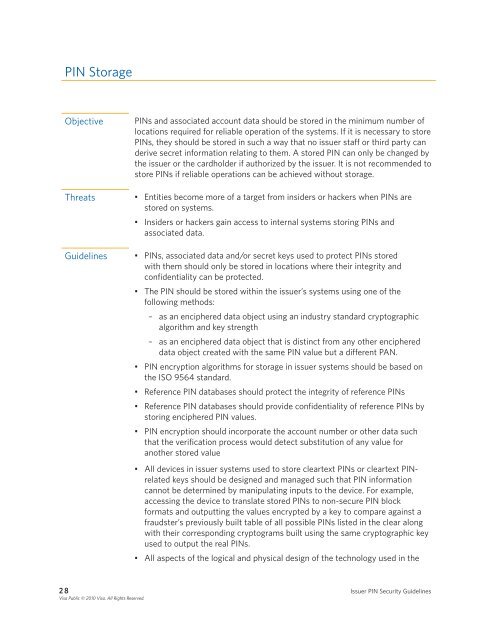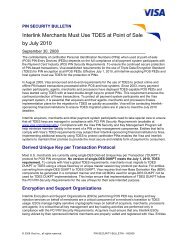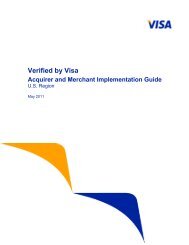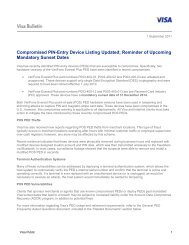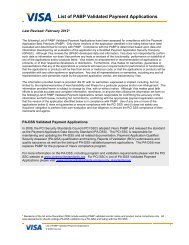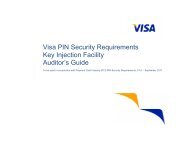Issuer PIN Security Guidelines - Visa
Issuer PIN Security Guidelines - Visa
Issuer PIN Security Guidelines - Visa
You also want an ePaper? Increase the reach of your titles
YUMPU automatically turns print PDFs into web optimized ePapers that Google loves.
<strong>PIN</strong> Storage<br />
Objective <strong>PIN</strong>s and associated account data should be stored in the minimum number of<br />
locations required for reliable operation of the systems . If it is necessary to store<br />
<strong>PIN</strong>s, they should be stored in such a way that no issuer staff or third party can<br />
derive secret information relating to them . A stored <strong>PIN</strong> can only be changed by<br />
the issuer or the cardholder if authorized by the issuer . It is not recommended to<br />
store <strong>PIN</strong>s if reliable operations can be achieved without storage .<br />
Threats • Entities become more of a target from insiders or hackers when <strong>PIN</strong>s are<br />
stored on systems .<br />
• Insiders or hackers gain access to internal systems storing <strong>PIN</strong>s and<br />
associated data .<br />
<strong>Guidelines</strong> • <strong>PIN</strong>s, associated data and/or secret keys used to protect <strong>PIN</strong>s stored<br />
with them should only be stored in locations where their integrity and<br />
confidentiality can be protected .<br />
• The <strong>PIN</strong> should be stored within the issuer’s systems using one of the<br />
following methods:<br />
– as an enciphered data object using an industry standard cryptographic<br />
algorithm and key strength<br />
– as an enciphered data object that is distinct from any other enciphered<br />
data object created with the same <strong>PIN</strong> value but a different PAN .<br />
• <strong>PIN</strong> encryption algorithms for storage in issuer systems should be based on<br />
the ISO 9564 standard .<br />
• Reference <strong>PIN</strong> databases should protect the integrity of reference <strong>PIN</strong>s<br />
• Reference <strong>PIN</strong> databases should provide confidentiality of reference <strong>PIN</strong>s by<br />
storing enciphered <strong>PIN</strong> values .<br />
• <strong>PIN</strong> encryption should incorporate the account number or other data such<br />
that the verification process would detect substitution of any value for<br />
another stored value<br />
• All devices in issuer systems used to store cleartext <strong>PIN</strong>s or cleartext <strong>PIN</strong>related<br />
keys should be designed and managed such that <strong>PIN</strong> information<br />
cannot be determined by manipulating inputs to the device . For example,<br />
accessing the device to translate stored <strong>PIN</strong>s to non-secure <strong>PIN</strong> block<br />
formats and outputting the values encrypted by a key to compare against a<br />
fraudster’s previously built table of all possible <strong>PIN</strong>s listed in the clear along<br />
with their corresponding cryptograms built using the same cryptographic key<br />
used to output the real <strong>PIN</strong>s .<br />
• All aspects of the logical and physical design of the technology used in the<br />
2 8 <strong>Issuer</strong> <strong>PIN</strong> <strong>Security</strong> <strong>Guidelines</strong><br />
<strong>Visa</strong> Public © 2010 <strong>Visa</strong>. All Rights Reserved.


